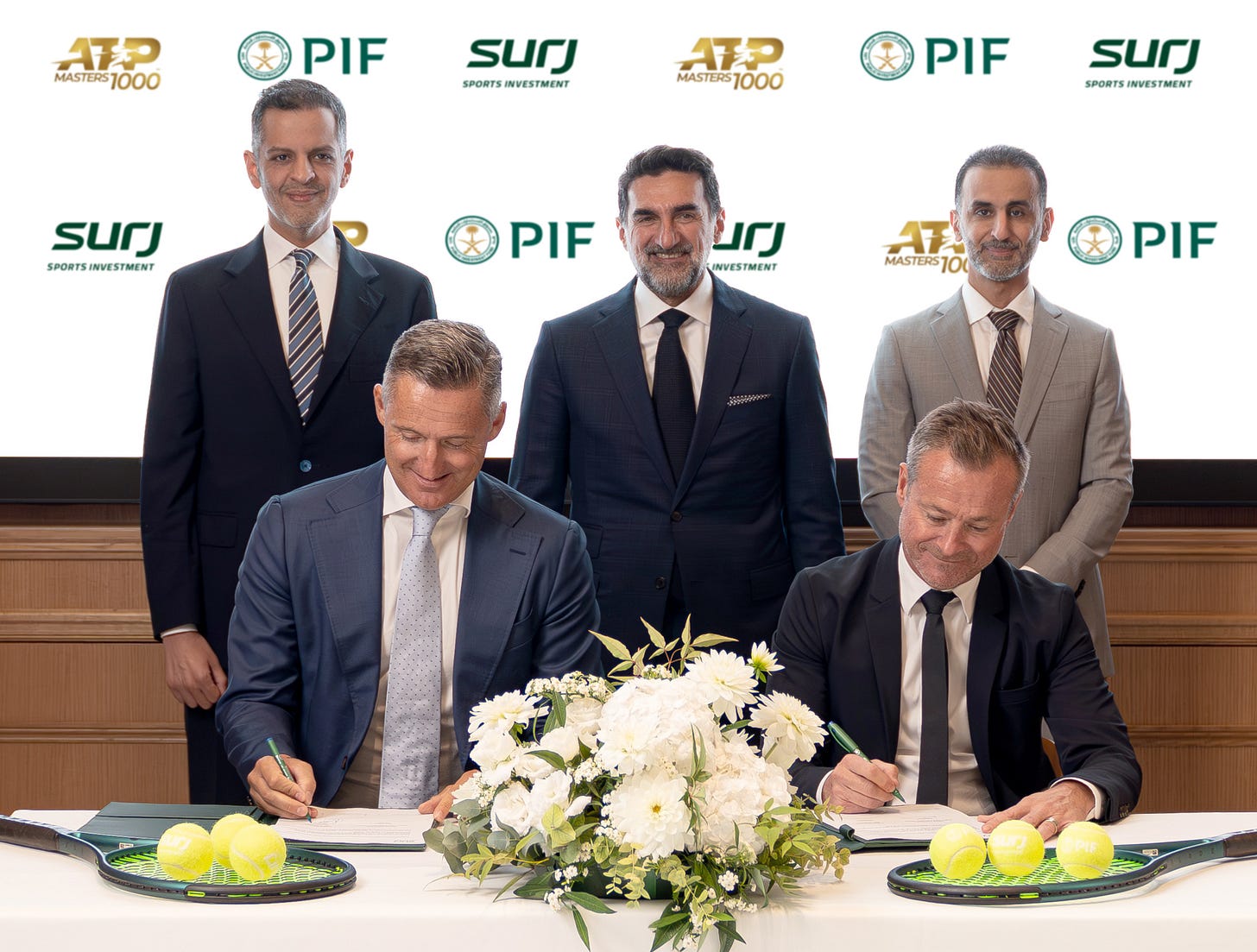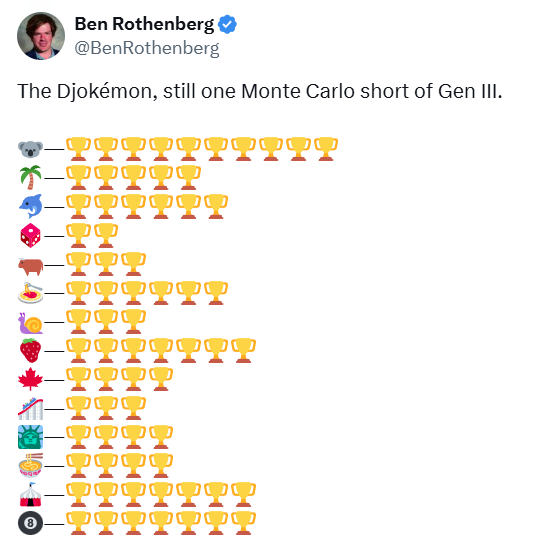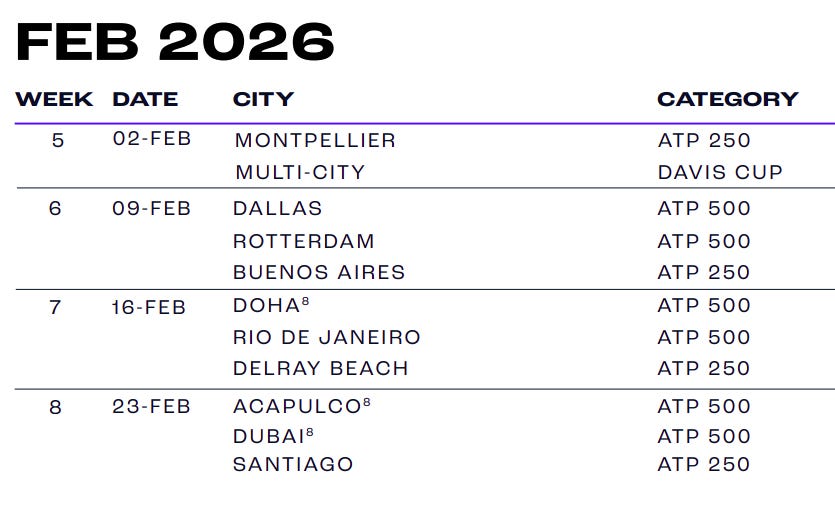ATP and Saudi Arabia: The Huge Difference Between 9 and 10
On the impact and consequences of the newly announced Saudi ATP 1000 event, which will force many smaller tournaments off the calendar.
The big news this week in men’s tennis was the ATP’s announcement on Thursday that, after nearly four decades of its elite nonet of Masters 1000 tournaments, a new 10th 1000-level tournament will be added to the calendar in a few years.
From the ATP’s press release:
“In what is the first-ever expansion of the tournament category, Saudi Arabia will become the tenth ATP Masters 1000 host, joining the existing nine tournaments in Indian Wells, Miami, Monte-Carlo, Madrid, Rome, Toronto/Montreal, Cincinnati, Shanghai and Paris. The Saudi tournament will begin as early as 2028.”

A lot of the conversation, understandably, will be about the decision to grant this tournament to the Saudi Arabian government (PIF and SURJ, the business behind this deal, are both government entities) after years of Saudis priming the pump by pouring incremental windfalls into tennis, and I will cover that angle of this here in due time. I think what the Saudis have done is really unprecedented: instead of building a tennis culture from the ground up, they’ve essentially landed straight onto a helipad atop the sport and walked right into the penthouse. There’s no grassroots pro tennis there—Saudi Arabia still didn’t host a single event on the ITF World Tour or ATP Challenger Tour this year—but their collection of the priciest items on the tennis menu grows.
In today’s Bounces I mostly want to explore ATP’s decision to create a 10th Masters 1000 event on its calendar, an unprecedented decision which no one had really been clamoring for in the sport until the Saudis arrived with offers the ATP couldn’t/wouldn’t refuse.
One of the underdiscussed factors in recent decades of men’s tennis, I think, has been calendar stability. After lots of competing tours and general chaos in the first couple decades of the Open Era, the men’s tour hit a very comfortable groove when it launched what was then called the “ATP Championship Series” for 1990. Despite several name changes—Super 9, Masters Series, Masters 1000—that tier has stayed pretty consistent, especially over the last stretch in which there have been minimal changes for nearly two decades.

Though no one has ever accused the tennis calendar of being perfect, I think that this period of stasis (which some might call stagnation) proved a sturdy foundation for much of the “Golden Era” of men’s tennis to take root. Fans who have followed and celebrated the Big Four, and more recently the Alcaraz-Sinner rivalry, have had a fixed set of big ATP tournaments to learn, and those tournaments have been a closed circle of nine.
Adding a 10th Masters 1000 is of course nowhere near as seismic or existential a change as codifying an official “Fifth Slam” would’ve been, but it’s still a change to the size of the canon of big tournaments.
Major wins are still the be-all, end-all currency in G.O.A.T. debates, but 1000-level titles became a frequently discussed metric as well, especially as Novak Djokovic became the first man to win them all once (and then twice, and now nearly thrice), a feat I dubbed “The Djokémon.” The stability of this category on the ATP calendar led me to creating these emojigraphics you may have seen on social media, tallying a player’s haul at the four majors, the nine 1000s, and the year-end championships.1
I have already picked out my emoji for this forthcoming Saudi 1000 (⚔️, because of the sword on the Saudi flag), but more official details about the event are still fairly scant.
The ATP has said that the event will be an old-school one-week tournament with a 56-player draw, bucking the trend of the two-week, 96-player draws that have taken over the category in recent years. Its closest analogue might be ATP 1000 Monte Carlo, which remains a breezy single week in the calendar compared to the tightly jammed trend.
But the ATP made the announcement while there are still many major details still yet to be confirmed: In which Saudi city will this tournament be held? Will this be an indoor or outdoor tournament? And, most crucially, when in the ceaselessly crowded tennis calendar will it be staged?
As Stuart Fraser of The Times of London wrote: “Whenever it is held, essentially the Saudi Arabia Masters is being shoehorned into a schedule that is already creaking at the seams.”
February seems most likely, based on early buzz, but early January before the Australian Open is also a possibility. Either way, this is a big new boulder landing in a very crowded pond, and the powerful ripples are going to wash a lot of existing tournaments onto the shores of oblivion.
In February alone, there are currently six ATP 500-level tournaments: Rotterdam, Dallas, Rio de Janeiro, Doha, Acapulco and Dubai.
To bring Bounces readers more about how this deal came to be, the reaction to it in top-flight men’s tennis, details of the deal, and how the dominos will fall for other events on tour, I talked with one of the most experienced leaders at the ATP 1000 level: Karl Hale, who has been the tournament director in Toronto since 2006.
Hale shared his enthusiasm for the deal and what he sees as the positive knock-on effects for the business of men’s tennis, which he called “transformative for the ATP Tour.”
We also discussed the repercussions for the rest of the tour, including how a Saudi-funded buyback program is going to reshape the tour, culling many existing smaller tournaments from the calendar to pave way for this new vehicle.
To read this interview full interview for all the insights and information within, please subscribe to Bounces! -Ben
Keep reading with a 7-day free trial
Subscribe to Bounces to keep reading this post and get 7 days of free access to the full post archives.




